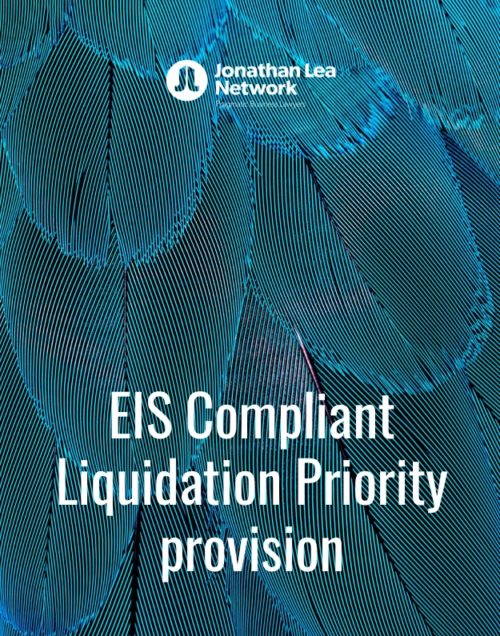EMI option agreement
£15.00
This product constitutes an easily adaptable EMI option agreement, together with a set of tailored guidance notes which provide helpful insights as to the template’s contents and aim to explain the key provisions of the document.
The EMI option agreement is a stand-alone document and will suffice when your company is granting EMI options to a single employee and does not envisage granting EMI options to other employees in the future. If you are thinking of implementing an EMI option scheme and granting options to multiple employees, this template will not be suitable and instead you will need to put together a generic (yet detailed) set of plan rules and issue each employee with an individual option certificate (which will contain specifics relating to that employee’s vesting and exercise conditions and any other terms that will apply only to that employee).
It is very much recommended that both employer and employee also each receive a detailed advisory letter setting out and explaining all the key aspects of how the EMI options work (including reference to relevant statutory provisions and time frames for HMRC notifications). Please get in touch if you would like us to assist with this area.
You will also invariably need a valuation report produced and agreed with HMRC before being able to finalise and grant the relevant EMI options. If required this is an area we can also cover and our experienced EMI valuation consultant tends to charge £1,500 for his work in agreeing a suitably low valuation with HMRC (so as to lower the exercise price employees pay to acquire the shares as much as possible).
This is a simple enterprise management incentive (“EMI”) option agreement which can be used for granting EMI options to a single employee.
This is a stand-alone document and the option agreement will suffice when your company is granting EMI options to a single employee and does not envisage granting EMI options to other employees in the future. If you are thinking of implementing an EMI option scheme and granting options to multiple employees, this template will not be suitable and instead you will need to put together a generic (yet detailed) set of plan rules and issue each employee with an individual option certificate (which will contain specifics relating to that employee’s vesting and exercise conditions and any other terms that will apply only to that employee).
Please note that there is no requirement for a company to formally adopt a separate EMI share option plan with a set of plan rules.
Given the legal/tax complexities involved with the implementation of such a scheme, we would always recommend that professional advice is sought beforehand.
While it is possible to grant non-qualifying options to individuals that do not qualify as ‘eligible employees’ under the relevant legislation, this option agreement has not been drafted in contemplation of non-qualifying options being granted. It will therefore only be appropriate where the company wishes to grant EMI options to a qualifying/eligible employee.
There are various ways that EMI share option schemes can be structured, which are (generally) as follows:
- on an ‘exit only’ basis;
- on a ‘time only’ basis; or
- on a ‘time and performance’ basis.
If an EMI share option scheme is structured on an ‘exit only’ basis this means that the option holder(s) will not be able to exercise their option(s) until an exit event occurs. Typically, an ‘Exit’ is defined as:
- a Share Sale; or
- an Asset Sale; or
- a Listing; or
- a Capital Raising (which the board of the company determines should be treated as an Exit.
A ‘Share Sale’ means the sale of (or the grant of a right to purchase or to dispose of) any of the shares in the capital of the company (in one transaction or as a series of transactions) which results in the buyer of those shares acquiring ‘Control’ of the company, except where the identities of the shareholders in the buyer and the proportion of shares of the buyer held by each of them following completion of the sale are substantially the same as the shareholders and their respective shareholdings in the company immediately before the sale.
The meaning of ‘Control’ in this context is defined in section 719 of the Income Tax (Earnings and Pensions) Act 2003 (“ITEPA 2003”) (as amended by section 995 of the Income Tax Act 2007 (“ITA 2007”)). Section 995(2) of the ITA 2007 defines ‘Control’ as follows:
“(2) In relation to a body corporate (“company A”), “control” means the power of a person (“P”) to secure –
(a) by means of the holding of shares or the possession of voting power in relation to that or any other body corporate, or
(b) as a result of any powers conferred by the articles of association or other document regulating that or any other body corporate,
…that the affairs of company A are conducted in accordance with P’s wishes”.
An ‘Asset Sale’ means the disposal by the company of all, or a substantial part of, the business and assets of the company.
A ‘Listing’ means the successful application and admission of all or any of the shares in the capital of the company, or securities representing such shares to the Official List of the UK Listing Authority or the AIM market operated by the London Stock Exchange plc, or the Nasdaq National Stock Market of the Nasdaq Stock Market Inc., or to any recognised investment exchange (as defined in section 285 of the Financial Services and Markets Act 2000).
A ‘Capital Raising’ means the issue of any shares in the capital of the company (in one transaction or as a series of transactions), which:
- will result in the subscriber for those shares acquiring ‘Control’ of the company; and
- which the board in its discretion decides should be treated as an Exit,
except where the subscriber is a company and the shareholders of that company, and the proportion of shares in that company held by each of them following the allotment of the shares are substantially the same as the shareholders and their shareholdings in the company immediately before the allotment.
If an EMI share option scheme is structured on a ‘time only’ basis, this means that as soon as the shares become vested (which will be in accordance with a vesting schedule so as to incentivise the employee to remain in employment with the company for a set period of time), the option holder will be able to exercise their option.
For example, say that you intended to grant EMI options to a key employee, ‘Mr A’. Propose further that, under the option, Mr A will receive up to 100 ordinary shares of nominal value £1.00 each in the capital of the company. If the scheme was structured on a ‘time only’ basis, you could propose a vesting schedule whereby Mr A receives 20 ordinary shares (i.e. 20% of the total number of shares being granted to him under option) per year over a five-year vesting period.
The vesting schedule in these circumstances would look as follows:
| No. of shares over which options vest | Date of vesting |
| 20 | First year anniversary of date of grant if option holder still employed by the company |
| 20 | Second year anniversary of date of grant if option holder still employed by the company |
| 20 | Third year anniversary of date of grant if option holder still employed by the company |
| 20 | Fourth year anniversary of date of grant if option holder still employed by the company |
| 20 | Fifth year anniversary of date of grant if option holder still employed by the company |
Alternatively, the EMI share option scheme could be structured so that, for example the whole of the option vests at once after five years from the grant date. This is different to the example set out above where a proportion of the option vests on a rolling basis (i.e. successively) each year over a five-year vesting period.
If an EMI share option scheme is structured on a ‘time and performance’ basis, this means that options will vest in accordance with a vesting schedule (like the hypothetical one set out above), but the options will not be capable of exercise by the option holder until certain exercise conditions are met. Exercise conditions could be performance-based, such as the company’s turnover or EBITDA being more than a certain amount for a given period of time. Alternatively, the exercise of the option could be linked to individual sales targets. Both of these are common exercise conditions given that they are objective and easily quantifiable metrics.
Our template EMI option agreement has been drafted on an exit only basis and therefore the option holders will only be able to exercise their option when an exit event occurs.
A qualifying EMI option must take the form of a written agreement between the grantor (i.e. the company) and the employee (i.e. the option holder). Under the relevant statutes underpinning EMI share option schemes, the option agreement must contain certain provisions and these have been included in our template document.
Agreement breakdown
Your input is required at the parts of the agreement highlighted in yellow and the wording inside the square brackets which we have included explains clearly the information that should be inserted. You are advised to fill in the wording in square brackets in lower case unless directed otherwise. Any figures should be entered in numerical form. The brackets should be removed after the amendments are made (so as to produce a ‘final form’ version of the agreement).
Below is a clause by clause breakdown of our template agreement. For the sake of expediency we have not explained the operation of each clause given that the majority are self-explanatory.
Parties
At sub-section (1), the company’s full name, registration number and registered office address should be inserted in the square brackets bolded and highlighted in yellow.
At sub-section (2), the individual’s full name and their residential address should be inserted.
Background
This section contains generic information explaining the rationale behind why the EMI share option scheme is being implemented by the company.
Sub-section (A) confirms that the company will grant EMI options to eligible employees of the company.
For the avoidance of doubt, an “EMI Option” is reference to a qualifying option as defined in paragraph 1(2) of Schedule 5 of the ITEPA 2003.
Although the term “eligible employee” is not defined in our template agreement, it is intended to refer to a full-time employee of the company granting the options who:
- spends on average at least the Statutory Minimum Time on the business of the company and/or the company’s group (if applicable);
- does not have a Material Interest (either alone or together with one or more Associates) in the company and/ore the company’s group (if applicable); and
- has no Associate or Associates who or which has or (taken together) have a Material Interest in the company and/or the company’s group (if applicable).
For the purposes of the above, the capitalised terms have the following general meanings:
- “Statutory Minimum Time” refers to committed time (as defined in paragraph 26 of Schedule 5 of the ITEPA 2003), equal to the statutory threshold (as defined in that paragraph). Paragraph 26(1) of Schedule 5 of the ITEPA 2003 provides as follows:
“For an individual (“the employee”) to be an eligible employee in relation to the relevant company the average amount per week of the employee’s committed time must equal or exceed the statutory threshold, that is –
- a) 25 hours a week, or
- b) if less, 75% of the employee’s working time”.
Paragraph 26(2) of Schedule 5 of the ITEPA 2003 states that an Employee’s “… ‘committed time’ means the time that the employee is required, as an employee in relevant employment, to spend –
- a) on the business of the relevant company, or
- b) if the relevant company is not a parent company, on the business of the group”.
Paragraph 27(1) of Schedule 5 of the ITEPA 2003 provides that “working time” means –
- “a) time spent on remunerative work as an employee or self-employed person, or
- b) time which would have been so spent but for any of the reasons set out in paragraph 26(3)(a) to (d)”.
Note finally that paragraph 26(3) of Schedule 5 of the ITEPA 2003 states as follows:
“It (i.e. an employee’s committed time) includes any time which the employee would have been required to spend as mentioned in sub-paragraph (2) but for –
- a) injury, ill-health or disability,
- b) pregnancy, childbirth, maternity or paternity leave or parental leave,
- c) reasonable holiday entitlement, or
- d) not being required to work during a period of notice of termination of employment”.
- The company cannot grant an EMI option to an individual who holds a “material interest” in the company and/or any group company (if applicable). In broad terms, a material interest means holding, or having a right to acquire, 30% or more of the company’s share capital or assets. The full definition is more complex and takes account of shares and options held by connected persons and therefore we advise seeking professional advice from experienced advisors on this point if you are in any doubt over whether a particular individual has a material interest or not.
- An ‘Associate’ has the meaning given to associate by paragraphs 31, 32 and 33 of Schedule 5 of the ITEPA 2003, with Chapter 11 of Part 7 of the ITEPA 2003 being applied for the purposes of paragraph 32(2).
At sub-section (D), you should include the wording contained within square brackets and highlighted in yellow if you are granting options to a new employee as part of their recruitment package. If the options is being granted to an existing employee, then this optional wording can be removed.
Clause 1 (‘Interpretation’)
This section of our template contains the defined terms used throughout the agreement.
You will note that the defined terms “Bad Leaver”, “Exercise Condition”, “Good Leaver” and “Relevant Restriction” are all highlighted in yellow and contained within square brackets.
If you wish for the EMI share option scheme to contain provisions pertaining to Good Leavers / Bad Leavers (and therefore wish to include clauses 3.6 and 3.7 which are also highlighted in yellow and contained within square brackets), then you should include both of these defined terms in your option agreement.
If the option being granted is not to be subject to any Exercise Conditions then the “Exercise Condition” definition can be omitted.
If the option being granted is not to be subject to any Relevant Restrictions then the “Relevant Restriction” definition can be omitted.
Clause 2 (‘Grant of Option’)
Option shares may be acquired either by subscription and the allotments/issue of new shares to the option holder or by the transfer of existing shares to the option holder. The use of the term “acquire” in clause 2.1 covers both possibilities.
Clause 2.2 ensures that if the employee fails to sign the option agreement within 30 days, the option will immediately lapse and cease to be exercisable on the Business Day after the 30-day period has elapsed.
The requirement for the employee to confirm that they comply with the EMI working time rules is set out in paragraphs 44(5) and (6) of Schedule 5 to the ITEPA 2003, and this is the purpose behind clause 2.4(b). Without this declaration, the option cannot be a qualifying EMI option.
Clause 3 (‘Exercise of Option’)
Clause 3.1 confirms that the option cannot be exercised until an Exit event occurs or, if no such event occurs, then the Business Day immediately prior to the tenth anniversary of the Grant Date (this is because an EMI option cannot be exercised on a date later than the tenth anniversary of the Grant Date) – such date being called the “Exercise Date”.
Clause 3.2 confirms that once the option is exercised and the option holder has paid the Exercise Price, the company will execute a relevant stock transfer form so as to evidence that the option shares have been acquired by the option holder.
Clause 3.5 warns the option holder that the option will immediately lapse and cease to be exercisable on an attempt to do anything listed in clause 3.5(a) and/or 3.5(b). This is a statutory requirement for EMI options under paragraph 38(a) of Schedule 5 of the ITEPA 2003 and should not be deleted.
Clause 3.6 and 3.7 are optional clauses that may be included if you wish for the EMI option agreement to make provision for Good Leavers / Bad Leavers. If you do not wish for the scheme to make such provision then these optional clauses can be removed in their entirety (along with the Good Leaver / Bad Leaver definitions under clause 1).
Clause 4 (‘Exercise Conditions and restrictions applying to the Option Shares’)
Whether or not you include the optional wording relating to Exercise Conditions will depend on whether you wish to stipulate that any conditions should apply to the exercise of the options (i.e. performance-based conditions such as the company meeting certain turnover targets or the employee meeting individual sales targets).
If you wish for the option to have Exercise Conditions attached, then the definition of “Exercise Conditions” should be included under clause 1 and the Exercise Conditions themselves should be elucidated in Schedule 1 of the agreement.
Clause 5 (‘Restrictions applying to the Option Shares’)
The EMI legislation requires certain restrictions applying to shares subject to an EMI option (if any) to be detailed in the option agreement.
If there are any Relevant Restrictions, choose the first optional phrase. If not, use the alternative wording to show there are no Relevant Restrictions.
If there are Relevant Restrictions attaching to the Option Shares, then the definition of “Relevant Restrictions” should be included under clause 1 and the Relevant Restrictions attaching to the Option Shares should be elucidated in Schedule 2 of the agreement.
Clause 6 (‘Tax and national insurance contributions (NICs)’)
If optional clause 6.2 is included, the company may require the employee to reimburse, or accept a transfer of, transferable employer’s NICs liabilities in respect of the option.
Clause 6.3 gives the company the right to withhold shares if the option holder fails to meet the tax obligations outlined in clause 6.1. In clause 6.3(a), a period of seven days would be a reasonable period of time for the option holder to meet the tax obligations before the withholding provisions apply (and we would therefore advise that this timeframe can be increased if desired but should not be decreased). The time period mentioned here will need to mirror the period specified in the accompanying plan rules for the scheme.
Clause 6.5 obliges the employee to enter into a restricted securities election if required to do so. This is a complex area that cannot be explained briefly/simply and so if you require further information/advice on this point you should consult experienced advisors.
Clause 7 (‘Power of attorney’)
This clause confirms that the employee appoints the company to act as its attorney to do anything required under clauses 6.3 and 6.5.
Clause 8 (‘No entitlement to compensation or damages’)
Clause 8.1 provides important protection for the company (in its capacity as the grantor) as it sets out exclusions of liability if the option does not, for any reason, attract the full benefit of the EMI tax reliefs.
Clause 8.2 confirms that the employee has no right to compensation or damages where they suffer any loss in respect of the option where that loss arises (or is claimed to arise) from the termination of the employee’s employment with the company for any reason.
Clause 8.3 prevents the employee from arguing that they have a right/contractual entitlement to receive options, regardless of whether the company has previously granted them options or not.
Clause 9 (‘Variation of share capital’)
It is possible to vary the terms of an EMI option to reflect a change in the company’s share capital. However, this should be approached carefully and with caution, because if the variation increases the value of shares under option, it may be a Disqualifying Event (as defined in our template agreement).
This clause provides reassurance to the employee that if the company decides to vary its share capital then the number of Option Shares to which the option relates shall alter accordingly so that the employee’s percentage holding in the company remains the same or as close as is possible to the percentage that they held immediately before the variation of share capital.
Clause 10 (‘Counterparts’)
Counterparts clauses are useful where the parties are executing separate copies of an agreement and are primarily used in transactions where there will be no single copy of the agreement that all parties have signed.
A counterparts clause may help to prevent a party from claiming that an agreement is not binding because there is no one copy of it that is signed by all parties, or because they did not know that they were entering into a binding contract by signing an agreement not signed by the other parties.
The inclusion of this clause simply gives the parties the option to sign/execute separate copies of the option agreement instead of them both having to physically sign the same copy of the document (this may be useful where the parties are based in different geographical locations which makes arranging signing of the same physical document a logistical issue).
The presence of a counterparts clause does not prevent the parties from signing the same physical copy of the agreement if they wish to do so, it just gives the parties the option/flexibility to execute the agreement in counterparts if this is easier.
Clause 11 (‘Governing Law and Jurisdiction’)
Clause 11.1 is a governing law clause. This clause specifies the system of law (in this case the law of England and Wales) that will apply to the interpretation of the agreement and its effect if a dispute arises. It identifies the substantive law that will be applied when determining and interpreting the rights and obligations of the parties and any disputes that may arise, but it does not indicate how disputes are to be resolved, for example through the courts or arbitration.
Clause 11.2 is a jurisdiction clause. This is a dispute resolution clause which identifies which court or courts are to hear a dispute (in this case the courts of England and Wales have shall have exclusive jurisdiction to hear and settle any such disputes).









